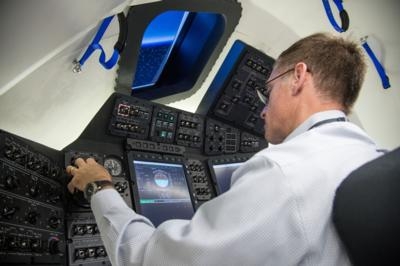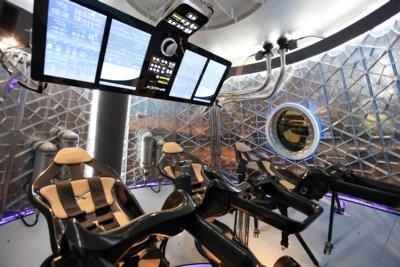Still, Pilots Will Be Able To Override The System If Necessary
The next American spacecraft astronauts fly aboard to the International Space Station will be more automated than any that have come before thanks to advances in technology and software. These advances also have potential to reduce stress on the crew.

NASA's Commercial Crew Program (CCP) is working with private industry partners Boeing and SpaceX to develop control systems that achieve a robust balance between computer and pilot guidance. In other words, the onboard computers will navigate the spacecraft into orbit and then to the station. Near the end of the mission, the crew would be able to climb inside the spacecraft after months in orbit and let the spaceship fly them home to Earth safely.
The systems also will allow a pilot to control the spacecraft to fulfill the mission if things do not go as planned. "We really want these vehicles to need very little interaction by the crew," said Justin Kerr, manager of the Spacecraft Office for CCP. "We have, though, added manual control capability in the event the automated systems don’t work because the best computer in a spacecraft at those times is the human."
Since the beginning of the space age, finding the balance of control between human and machine has been a careful pursuit. Automated systems have controlled aspects of missions, but astronauts kept control through some vital stretches of flights, such as when Mercury astronauts determined their re-entry attitude, when Apollo commanders touched down on the moon, and when space shuttle pilots steered the spacecraft to the runway. "You can have a computer and sensors looking at the situation and calculating what the control input is or you can have a person with their eyeballs and their brain and their hand on the stick," Kerr said. "Either one is doable."
Today, cargo resupply spacecraft heading to the station are guided by computers while ground controllers watch over their approach to the orbiting laboratory. The results of those missions have given NASA the confidence it needs to plan for crewed missions to the station. "Just because it's automated doesn't mean it's completely hands-off," Kerr said. "But monitoring systems is less time-consuming for the whole crew than flying the spacecraft. It will free the crew to do the highest priority task at the moment as well."
For the new generation of spacecraft, automation is not seen as a replacement for pilots but as a mechanism to reduce risk and workload by having computers and avionics perform roles that don't necessarily need a human hand now. "We have seen so much advancement in the commercial cargo resupply missions that we are very comfortable with our partners applying innovations to crewed spacecraft, lowering the work that has to be done onboard during a mission," said Kathy Lueders, manager of CCP. "The astronauts have plenty to do during a flight no matter which phase they are in, so taking some of the work and giving it to the computers where possible is not a hard choice to make."

Also, emergency situations may call for a quick getaway back to Earth. "The intent here is to be predominantly automated so that, particularly in an emergency lifeboat scenario, you want to be able to have the crew jump in, close the door, hit the easy button and come home," Kerr said. "We really want it to be as close to the Star Wars vision of the escape pod as possible."
NASA selected Boeing and SpaceX to finalize their respective CST-100 and Crew Dragon designs then build and fly their spacecraft on test flights with crews to the station. Work continues toward fulfilling the contract terms, including producing the automated systems. "It's not a big step technology-wise," Kerr said. "I think it's a big step in thinking and getting comfortable with that approach. The technology has been there. It was there with shuttle, but shuttle was not meant to fly automated, although it was only a cable away from being able to. For commercial crew vehicles, it has been more about the verification area, more in the mindset and getting people to change the paradigm a bit."
CCP’s providers will spend hundreds of hours running the automated systems through a variety of plausible situations and full-scale flight deck models that will show astronauts can fly through emergency scenarios of all sorts. "You could design and build the best automated system in the world, it could be the easiest to use, not require any interaction by the crew . . . those are all good things," Kerr said. "But in the end, if a bad day happens, you want a trained professional in that vehicle with the right controls and interfaces in place to get you home."
(Images provided by NASA)
 Airborne 04.16.24: RV Update, Affordable Flying Expo, Diamond Lil
Airborne 04.16.24: RV Update, Affordable Flying Expo, Diamond Lil ANN's Daily Aero-Term (04.20.24): Light Gun
ANN's Daily Aero-Term (04.20.24): Light Gun Aero-News: Quote of the Day (04.20.24)
Aero-News: Quote of the Day (04.20.24) Aero-News: Quote of the Day (04.21.24)
Aero-News: Quote of the Day (04.21.24) ANN's Daily Aero-Term (04.21.24): Aircraft Conflict
ANN's Daily Aero-Term (04.21.24): Aircraft Conflict




